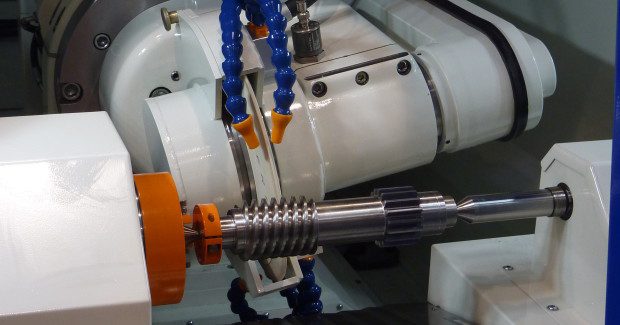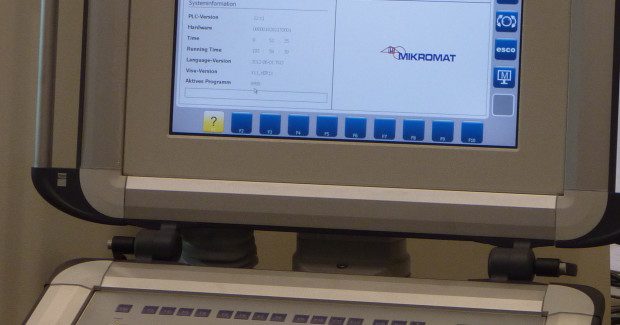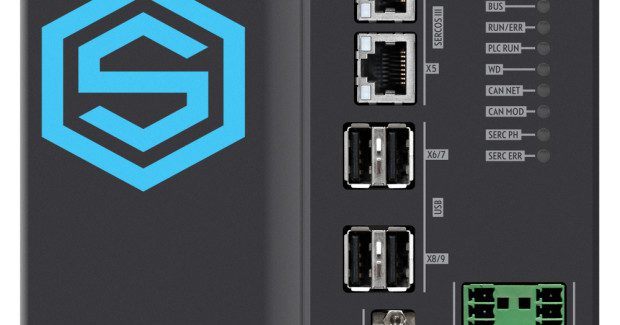Precision Grinding With Graphical Monitoring
The special controls used by thread grinding machine tool builder Mikromat keeps their machines simple to operate as they get faster and more precise to meet complex aviation, aerospace, marine and automobile applications.
Posted: February 3, 2016
In the domain of precision manufacturing, CNC machines have essentially replaced manually-operated machine tools in most production shops. Machine tools are operated via an electronic box and computer programs that can be adjusted and monitored with considerably more precision than manual levers, cranks and handwheels. The truth is that classic CNC programming via G-code is complicated and cumbersome because each individual program step must be manually entered into the input screen of the HMI device. Up to 1,000 lines of hand-typed commands must quickly come together. On top of that, the classic CNC control panel can also be confusing, composed of countless buttons with various letters, numerals, characters and symbols.
This is why Mikromat GmbH (Dresden, Germany) adapted its thread grinding machines to a simpler operating scheme 26 years ago, starting with the handling of the user interface. “Simple operation is important for our customers, so that a smooth flow and high-precision results are guaranteed,” noted Gerd Schäfer, the company sales manager and the person responsible for their thread grinding application technology. Up to 2009, this machine tool builder still ran their G-series grinding machines on a DOS-based system because it was a proven operating system. The system was outdated and no longer able to run on modern computer systems. “We had to switch to a Windows-based system,” added Schäfer. “Thanks to this system, the common graphic user interface standards that exist today are achievable.”
Given the new generation of the system, Mikromat had to find a new and reliable control system. Their grinding machines are required to meet especially high standards in dimensional accuracy and complexity. To achieve the specified basic size, the required accuracy in the manufacturing process, and to prevent erroneous grinding processes, a clear and easy-to-understand control operation is necessary. But even the user interface of new CNC technology can be a major challenge for inexperienced users – they must first be trained in how to use the machine.
To ensure a quick and easy incorporation, Mikromat placed special emphasis on monitoring, where the user interface works via insertion in a drawing template. As many tools as possible could be created so that the user can find these understandable and easy to operate. Another important criteria was control implementation within an open system. “We have clients in various industries and with various requirements,” added Schäfer. “With an open system, we can program the monitoring individually, according to our customers’ visions.”
With these criteria defined for the new monitoring system, the search began for a supplier. The machine tool builder selected control manufacturer Schleicher Electronic Berlin GmbH (Berlin, Germany). They offer an open control with the XCA 1277 monitoring system that provides Mikromat with an enormous range of design freedoms. The user interface can be modeled on the drawings of the technologies with the end client, and the control functions are limited precisely to its requirements. To date, no other control for thread grinding machines can offer such freedom of creativity.
The XCA 1277 is extremely easy to use. All grinding and access data can be easily inserted in the screens, without any need for programming skills. Any language barriers are removed by internationally understandable imagery. “Our grinding machines are used in Russia, China and Europe, but many of our end clients don’t speak English,” says Schäfer. “For this reason we use graphics, with as little text as possible.” Another advantage of XCA monitoring is that the program can be input even when the machine is running, which significantly shortens the workflow.
The XCA 1277 is a high performance controller with enormous computing power to monitor many interpolating axes. The Ethernet connection of the Schleicher monitoring system assures internal integration of the machine during the technical process, making the system an ideal module for Industry 4.0 applications. A Schleicher control system was also used in the predecessor version of the thread grinding machine. “In our XCA we have combined tried and tested functions with the most modern configuration requirements,” explained Sven Dübbers, the chief executive officer of Schleicher Electronic. However, the new integrated Embedded System communicates via a PC while the CNC monitoring runs in real time on a separate core.
The resulting technological options, together with the open surface design, allow for a more effective, universal use of the thread grinding machines.
Schleicher USA, 2747 Route 20 East, Cazenovia, NY 13035, 800-321-9539, [email protected], www.schleicher.berlin.

















